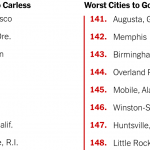Diana Six’s love of the outdoors began before she could form words, run, or collect the bugs and fungi that were precious to her as a child. A tough home life eventually led her to drop out of school and live on the streets. But biology classes in community college helped Six discover her calling in studying various forms of life. “They took me right back to how I was as a kid,” she says.
Now an entomologist at the University of Montana, she has spent the last 30 years researching how bark beetles are decimating pine forests. But a constant, haunting depression has taken over her life. A recent trip to Glacier national park spurred her to vent some of this emotion in a tweet that went viral and resonated with many: “Glacier National Park. 97F in June. Little snow left. 75F degree water. Glaciers disappearing. That is what we hear. But the worst is what most never see.”
To Six, the climate crisis isn’t just decimating glaciers and life on Earth. It’s taking her identity with it. She recently spoke to the Guardian about her changing role on the land she loves.
“I don’t think people realize that climate change is not just a loss of ice. It’s all the stuff that’s dependent on it. The ice is really just the canary in the coalmine. To have 97, 98 degrees in Glacier national park for days on end is insane. This is not just some fluke.
“There are many years where the snow is gone so early that you just don’t see it in the mountains. And water getting that warm is absolutely devastating to fish and algae.
“Life doesn’t just deal with this. When I went up Glacier with my students a few weeks ago, the flowers were curling up. At some of the lower elevations, glacier lilies were shriveled, lupins didn’t even open. The flowers should extend for another three weeks and they’re already gone. Any insects or birds that depend upon them, like bees or hummingbirds are in trouble, their food is gone. Bird populations have just baked.
“There have been total losses of a lot of baby birds this year. You see these ospreys and eagles sitting on top of the trees in their nests and those young, they just can’t take the heat. Year after year of that and you lose your birds.
“People seem to think of extinctions as some silent, painless statistic. It’s not. You look at birds that can no longer find fish because they’ve moved too far off shore. They’re emaciated, they’re starving to death. We are at the point that there’s nothing untouched.
“I’m also an artist. I recently finished a 10-week art course called Identity in America where the instructor made us use a medium we had not worked with before, because he felt we couldn’t go back to old habits. I ended up drawing myself morphing from being an ecologist to the guys who walked around during the plague to bring out the bodies.
“When I was forced to actually confront my identity, I realized that I’m no longer doing what I thought I was. My whole life has been documenting how life works, how we can conserve species that are in trouble. I was no longer cataloging life and finding ways to prevent ecosystems from reaching tipping points. I had actually hit my own tipping point. Somewhere along the way, I had gone from being an ecologist to a coroner. I am no longer documenting life. I’m describing loss, decline, death. And that is what is accounting for my kind of overwhelming sense of grief.
“This is what really brought home to me that my entire job has changed. I don’t like my new job, but I can’t quit. Even if I quit being a professor and doing research, I’m always going to be a coroner now.
“When I started work, I didn’t think about climate change. It was far enough back that people were still kind of wondering, is it really happening? Then pretty early in my career as a professor, I realized I had to incorporate climate change into most of what I was doing. These tree-killing bark beetles I study have always had outbreaks. It’s not anything new. But when mountain pine beetle developed this most recent outbreak, it was so far out of the norm in size and severity, we couldn’t ignore that.
“I would walk through these forests and almost everything was dead. When you see a beetle kill 70 acres of trees across North America, you just have to change your research questions. My focus had to shift from the beetles to how we can help our forests survive this. You have to come at these systems from a completely different direction now.
“We’re coming at things all wrong, trying to save a species by putting it in a zoo or replanting trees. But if you aren’t going to the root cause of the problem it’s still going to happen. That’s not to say that if we didn’t just get our act together and make some major changes, we couldn’t save some of this. We just can’t do it one species at a time.”

Average Rating